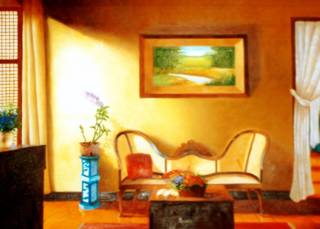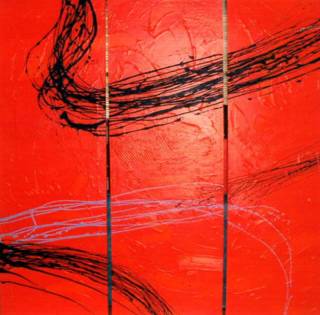FROM REALISM TO ABSTRACTIONISM
On-going One-Man Show at BMW Prestige, BMW Philippines.
The exhibit runs up to March 10, 2005, Pasong Tamo, Makati, Philippines
In his 1981 oil painting titled “Rendezvous”, realist painter Carlo Magno poignantly portrayed a nostalgic scene of lovers’ meeting place – an old church – a visual allusion to the Philippine classic Kundiman song “Lumang Simbahan” popularized by Larry Miranda.
Rendesvous, 1981, Oil on canvas by Carlo Magno.

Reprinted from the book "A Century of Realism in Philippine Art"

Reprinted from the book "A Century of Realism in Philippine Art"
Rendered in a romantic chiaroscuro, the painting depicts an interior of the uppermost floor of the belfry with a huge imposing window at the center as the source of cascading light. Close to the windowsill are two wooden chairs facing each other and in-between, a single fresh rose lying on the jagged floor.
Based on the visual narrative, one can surmise that one of the lovers failed to come at the rendezvous, probably the woman, as indicative of an abandoned flower that was deliberately dropped on the floor to show the lover’s frustration to his beloved. However, one creature is visibly present at the scene – a dove standing patiently on the rail across the window with its slightly exaggerated long neck as if it were looking at a distance waiting for someone…
This emotionally charged imagery is only one among the countless realistic paintings of Carlo Magno who, for 22 years of his artistic career, has masterfully portrayed images from the detailed depiction of old churches and houses to the intricate and dramatic interplay of lights and shadows of the interiors.
Based on the visual narrative, one can surmise that one of the lovers failed to come at the rendezvous, probably the woman, as indicative of an abandoned flower that was deliberately dropped on the floor to show the lover’s frustration to his beloved. However, one creature is visibly present at the scene – a dove standing patiently on the rail across the window with its slightly exaggerated long neck as if it were looking at a distance waiting for someone…
This emotionally charged imagery is only one among the countless realistic paintings of Carlo Magno who, for 22 years of his artistic career, has masterfully portrayed images from the detailed depiction of old churches and houses to the intricate and dramatic interplay of lights and shadows of the interiors.
Interior, 2000, Oil on canvas by Carlo Magno.

Photo by Danny Sillada. Copyright 2003. Posted by Hello

Photo by Danny Sillada. Copyright 2003. Posted by Hello
Today, Carlo Magno has dramatically metamorphosed from his two-decade pursuit of realism into a more profound search of esthetic expression. The deconstruction of forms and colors in his works, for instance, surprised his collectors and followers alike – how he reinvented his artistic style from realism into a more challenging field of abstractionism. The dramatic change of his creative output is remarkably groundbreaking which can be ranked side by side with the foremost Filipino abstractionists such as Lao Lianben, Raul Isidro and Gus Albor, to name a few.
Conversely, the current oeuvre of Carlo Magno is, distinctively, the antithesis to his previous portrayal of realistic images. His forms and colors are literally diffused and melted on the surface of his canvas. The visual illusion of lights and shadows has been altogether defaced - the pictorial climax vanishes, and the flattened surface becomes the epitome of his inexhaustible esthetic interpretations.
In his crimson works, for instance, the thick color of deep red has been inescapably spread out in every corner of the canvas. At the center, an undefined form is minimally embossed, almost invisible yet protruding, creating an illusion of dynamism amid the opaque surface of the painting.
Equally arresting, is his five-foot tall triptych where the undulating streaks of black and calligraphic lines, in contrast to the vermilion-toned background, are running across at the upper and lower portions of the picture, a reminiscent of Jackson Pollock’s dynamic paint drippings.
Carlo Magno’s breaking out from the safe zone of his aesthetics is, preemptorily, a welcome precedent to most Filipino artists who have shared the same predicament of being confined from one’s style and from the dictate of the art market. For every artist has a dream and a vision to trudge upon the uncharted bastion of his esthetic creativity. He is hampered, however, to take a single stride lest he loses his artistic identity and eventually, his source for subsistence.
Carlo Magno, on the other hand, has proven himself that there is no risk of reinventing oneself as an artist if it is geared toward a more meaningful and creative pursuit. Surprisingly, the monetary success of his exhibitions as abstractionist painter is enough to prove that an “identity” of an artist to a particular genre is only accidental. What really matters is the persistence to create and the unremitting desire to be creative without confining oneself to the “formulaic versions” of one's style and techniques.
Carlo Magno
Along with his transformation, Carlo Magno embraces and recognizes the unlimited possibilities of post-modern art, where the concept of Aristotelian’s poetics, which is imbibed by Philippine culture, is dead. It belongs to the Greco-Roman art of the past, and what is tangible is here, the art of our time as reflected by our fast-changing society - bold, radical and, at times, irrational.
Copyright © 2004 by Danny Sillada [δακασί].





